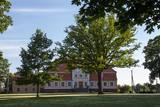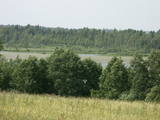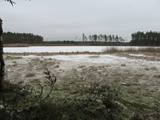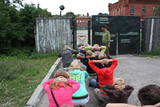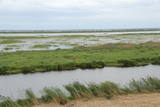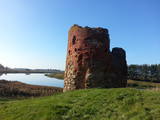| Нo | Название | Описание |
|---|---|---|
|
Sprižu ģimenes bioloģiskā saimniecība "Dabas Gardumi" atrodas Mārupes novadā un tā apsaimnieko ogulājus 23 ha platībā. Audzē avenes, upenes, jāņogas, ērkšķogas, sausseržus, piparmētras, ābolus, plūmes u.c. Visas ogas svaigā veidā tiek piedāvātas sezonas laikā, kā arī tiek pārstrādātas, no kurām ražo dažādus augļu - ogu gardumus: augļu-ogu bumbiņas, salmiņus, sulas, marmelādes un tējas. Saražotā produkcija ir dabiska, garšīga, veselīga, šķiedrvielām un vitamīniem bagāta, jo pārstrādes procesā augļiem, ogām un garšaugiem tiek saglabāts pēc iespējas lielāks tā dabiskais sastāvs. Pārsvarā gardumi top no pašu izaudzētiem un savāktiem dabas izejmateriāliem (augļi, ogas, garšaugi), ražotajiem produktiem netiek pievienots cukurs, līdz ar to augļu-ogu gardumi ir lieliska gan ikdienas, gan svētku uzkoda kā maziem, tā arī lieliem baudītājiem. |
||
|
Маршрут проходит по прекрасным цветочным садам Курземе и Жемайтии. В Кандаве находится самая большая коллекция ирисов. «Миеркални» является крупнейшим садом лилейника в Восточной Европе с более чем 1000 его сортами. Владелец производит также фруктовые и ягодные вина. В природном парке Талсинской возвышенности находятся яблоневые сады Курземниеков, где можно приобрести фрукты или продукты из них (сушеные яблоки, яблочные чипсы, соки). В хозяйстве окружающей среды и здоровья «Упмали» готовят чай, смеси из трав, растительные масла, особые бальзамы, косметику, травяное мыло и т. д. - под маркой Анна Берманс. В Саулескалнском дендрарии находится самая старая в Латвии 50-летняя магнолия. Более 100 сортов пионов выращивают в саду Зиедоню. Владельцы усадьбы Марас предлагают исторические рассказы немецких усадеб района Кулдиги. В молочной усадьбе Бергхоф находится Музей молока. В дендрологическом саду Мара Линде можно найти экзотические сорта цветов и деревьев. В фермерском хозяйстве «Турайдас» производит травяные чаи и чайные мешочки для сувениров или подарков, используя малину, пижму, манжетку, подорожник и цветы липы. В поселке Ница путешественники могут посетить несколько декоративных садов, которые поддерживают местные традиции садоводства. В Руцавском дендрарии можно осмотреть коллекцию магнолий. Самый большой японский сад в Европе (16 га) - это место для коллекции традиционных ароматических растений и овощных культур. Усадьба в Паланге, где расположен Музей янтаря и парк Бирутес является одним из наиболее хорошо сохранившихся усадебных комплексов в Литве. Кретингский усадебный парк - один из старейших усадебных парков 16-18 в. в Литве. В ботаническом саду Клайпедского университета расположен прибрежный этнографический сад с типичными для этой местности сортами цветов. Клайпеда - самый популярный приморский курортный город в Литве. Морской музей и дельфинарий являются одной из самых известных туристических достопримечательностей Клайпеды. В усадьбе Шилуте есть два парка - английский ландшафтный парк с прогулочными дорожками и лесопарк, известный как Варнамишкис или так называемый «Вороний лес». Пакалне - это уникальный традиционный рыбацкий двор с садовыми растениями, характерными для этого региона Литвы. |
||
|
Усадьба Кельме представляет собой одну из немногих сохранившихся в Литве провинциальных усадеб в типичном для страны стиле барокко. Это большой усадебный ансамбль с законченной композицией, отличающийся обилием аутентичных построек, зеленых насаждений и водоемов. В усадьбе разбит геометрический парк, в котором до сих пор прослеживаются явные черты барокко. Парк делится на правильные части аллеями, пересекающимися под прямыми углами. В парке есть небольшой холм с обзорной площадкой. Большинство из растущих здесь крупных деревьев местных пород (дубы, клены, липы, ясени) представляют собой наследие старого парка. Украшением этого места являются большой пруд за дворцом, три более мелких пруда и холм с обзорной площадкой в старой части парка. |
||
|
Dabas liegumā ietilpst divi aizauguši ezeri ar grūti pieejamiem krastiem - Lielais un Mazais Asūnes ezers, kas atrodas dienvidos no Asūnes ciema. Abus ezerus var vērot, atrodoties ārpus lieguma teritorijas - no blakus esošo pauguru augstākajām daļām, kas atrodas austrumos no abiem ezeriem. Ja līdzi būs paņemts tālskatis, iespējams, izdosies iztālēm novērot šeit esošās aizsargājamās putnu sugas, piemēram, melno zīriņu. |
||
|
На пасеке можно познакомиться с жизнью пчел и купить мед разных цветов, прополис, одеяльца с прополисом, восковые свечи. Необычное для Латвии предложение - апитерапия, во время которой лечение проводится по старинным методам - в кровати, под которой расположены пчелиные ульи (созданное пчелами тепло, вибрация, биополе). |
||
|
This park is found in the Otepää highlands and offers an outstanding example of how the terrain of a protected natural territory can be used for recreation, sports and active leisure. The infrastructure of the park is perfect for such activities and is of a high level of quality.
|
||
|
This is one of the most impressive and extensive natural structures of its kind in Latvia in terms of appearance and landscape. The ice age left behind this wall-like terrain, which is up to 27 metres high and at the top of which the Rīga-Ērgļi road has been built. The Great Kangari hills offer a view of the Great Kangars lake and the Great Kangari swamps and ponds. The Ķoderi castle hill, also known as the “Big Man’s Bed” is found here. The restricted area was established to protect the structure and its related biotopes and plants.
|
||
|
Тюрьму военного порта не стоит описывать. Это надо пережить и выжить! И такая возможность предоставляется каждому. На сегодняшний момент это наилучший туристический продукт военного наследия, учиться на примере которого может любой.
|
||
|
2003.gada decembrī folkloras kopa „Atštaukas” izveidoja folkloras centru „Namīns”, kurā svin svētkus, organizē Jāņu ielīgošanu, Lieldienu iešūpošanu, Miķeļdienas tirgu, Annas dienas Saimnieču svētkus, tautiskos Ziemassvētkus. „Atštaukas” palīdz saglabāt un popularizēt dažādus latviešu tautas godību rituālus, gan kāzu, gan arī bēru tradīcijas. Folkloras centrā „Namīns” darbojas arī skola, kurā bērniem tiek mācīta folklora un tautas tradīcijas. |
||
|
Одна из выдающихся католических церквей Латвии. Осматриваемый сегодня каменный храм построен в 1761 году в стиле польского барокко. Сохранился оригинальный и очень роскошный интерьер (XVIII в.). Ежегодно здесь проводятся мероприятия духовной музыки и дни польской культуры. В сопровождении гида можно осмотреть церковь и другие туристические объекты приграничного района ЕС (необходимо наличие паспорта!) |
||
|
Piedāvā ļoti gardus Lietuviešu tradicionālos ēdienus. Var pieņemt līdz 1000 personām.Pieņem bankas kartes, ir āra terase, dzīvā mūzika kā arī autostāvvieta. |
||
|
This wooden pathway will introduce the visitor to a high-type swamp and a unique habitat – a place where sulphur streams flow into the Raganu swamp. The little lakes in the swamp are unique – they are the result of sulphur bacteria, and there is a special range of species in those lakes. The landscape is interesting, and the smell of sulphur pervades, mostly from sulphur ponds. The trail is 800m long and will require 20 minutes to an hour to traverse. The object is on the border of the Zemgale and Vidzeme regions.
|
||
|
Z/s Kotiņi pamatnodarbošanās ir graudkopība ar specializāciju sēklkopībā. Vieni no lielākajiem sēklas ražotājiem valstī. Apsaimniekojamās zemes platība ir 4500 ha, no kuriem 3500 ha ir augstu kategoriju sertificētas sēklas lauki. Audzē kviešus, miežus, rapsi, pupas, zirņus, auzas, rudzus, eļļas rutkus, sinepes, griķus, āboliņu, sarkano auzeni, timotiņu, Speltas kviešus. Saimniecība piedāvā produktus ar pievienoto vērtību:
Daļa no Kotiņu produktiem ir atzīti ar zaļās karotītes kvalitātes zīmi! Kotiņi ir saimniecība, kur lieto Latvijā ražotu 100% zaļu enerģiju. |
||
|
Кооперативный магазинчик розничной торговли, предлагающий продукцию от 29 производителей и ремесленников Кулдигского края. В течение всего года предлагается широкий и разнообразный ассортимент местных продуктов домашнего производства. |
||
|
Dabas liegums atrodas dienvidaustrumos no Lubāna ezera un tas veidots purva un meža biotopu un tajos esošo sugu aizsardzībai. Gar teritorijas ziemeļu robežu iet Nagļu - Degumnieku ceļš (iekļaujas kopējā Lubāna dambju sistēmā), pa kuru apkārt Lubāna ezeram izveidots velomaršruts. Tas nozīmē, ka teritoriju var aplūkot arī "no malas", netraucējot tās dabiskās norises. Teritorija ietilpst arī Lubāna mitrāja kompleksā.
|
||
|
Пилтене – это один из самых малых и древних городов Латвии. В исторических источниках Пилтене первый раз было упомянуто в 1295-м году, а стутус города был получен уже в 1557-м году. В период с 14-й по 16-й века Пилтене было административным центром Курляндского епископства. На исторических улицах, которые полукругом окружают руины замка, сохранилась деревянная застройка первой половины 19-го века. Пилтенский епископский замок был построен на рубеже 13-14 веков и использовался до 16-го века. До сего дня сохранился только фундамент и фрагменты башни на берегу Вецвенты. |
||
|
Восстановительные грязевые пруды
это место, где депонируются использованные
курортным и реабилитационным центром
"Яункемери" грязи.
|
||
|
Первая большая гидроэлектростанция в Латвии, строительство которой было начато в 1936 году (архитектор Э. Лаубе). Первый гидроагрегат (мощностью 17 МВт - крупнейший в странах Балтии) начал действовать в 1939 году. В период с 1976 – 1979 годы было проведен второй этап строительства ГЭС, в результате которого на левом берегу Даугавы построили новое здание, установили три агрегата, увеличив таким образом мощность ГЭС до 260 МВт. Еще одна реконструкция ГЭС прошла на левом берегу Даугавы (ГЭС – 2) в период с 1998 - 2001 годы, где сейчас расположен музей Энергетики. Посещение объекта проходит по предварительной записи! |
||
|
До наших дней сохранилось несколько строений Шлитерского хутора: дом прислуги (конец XIX в.), насосная (середина XIX в.) и коптильня (середина XIX в.), хлев и др. В 1936 году здесь построили здание лесничества (отреставрировано в 2010 г.), в которое с конца 2009 года вернулась из Дундаги администрация Слитерского национального парка - теперь Курземская региональная администрация Управления охраны природы. Напротив здания администрации растут два тиса, а разросшийся плющ обвил северную сторону стены дома прислуги. Тис обыкновенный и Балтийский плющ являются своего рода символами Шлитере, которые здесь можно увидеть и сфотографировать в одном месте, не тревожа их в естественной среде обитания. В насосной со времен Шлитерского фольварка, сохранился уникальный в масштабе Латвии колодец глубиной 34 метра (почти как высота всех Шлитерских Синих гор!), который работал до семидесятых годов ХХ столетия и снабжал водой комплекс лесничества. Каменный фрагмент обшивки колодца виднеется как часть стены насосной. Комплекс фольварка опоясывают небольшие фрагменты парка с аллеей внушительных ясеней. В свое время в одном из помещений здания лесничества ночевал после охоты K. Ульманис. |
||
|
Храм построен в 1766 г., а колокольня возводилась в 1897 году. Орган, построенный в 1859 году органным мастером Ансисом Динсбергсом, считается старейшим органом Латвии работы латышского мастера. Запрестольный образ «Пасхальное утро» создан Янисом Розенталсом в 1912 году. Церковь можно осмотреть изнутри. |
||




